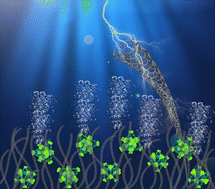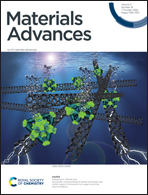Synergistic compounding of carbon nanotubes and metal–organic frameworks for oxygen-evolving electrocatalysis
Abstract
In this report, we demonstrate that utilizing multi-walled carbon nanotubes (MWCNTs) coated with a microporous metal–organic framework (UiO-66-NH2) that was doped with electrocatalytically active Ni(II) ions can produce a highly efficient heterogeneous electrocatalyst for the water oxidation reaction. The electrode material demonstrated an onset potential for the OER of 1.51 V vs. RHE (overpotential η = 0.28 V) and an outstanding overpotential at a current density of 10 mA cm−2 (η10 = 0.33 V), ultimately reaching a considerably high current density of 600 mA cm−2 at 2.05 V vs. RHE. The prepared electrocatalyst demonstrated maintained catalytic activity in a highly caustic 1 M KOH solution for at least 7 hours of continuous controlled current electrolysis. This approach is synthetically appealing due to its applicability to several other systems through combining functional microporous MOF deposition on a conductive carbon support with minimal modifications, opening the door for cheap and efficient heterogeneous electrocatalysts for energy storage and conversion technologies.

- This article is part of the themed collection: Popular Advances


 Please wait while we load your content...
Please wait while we load your content...